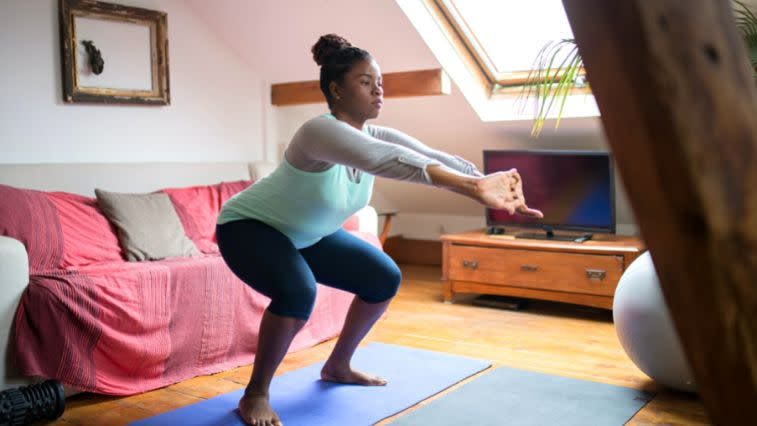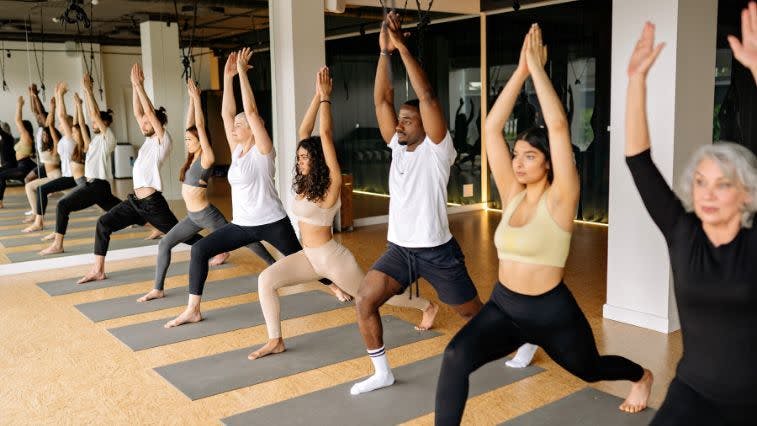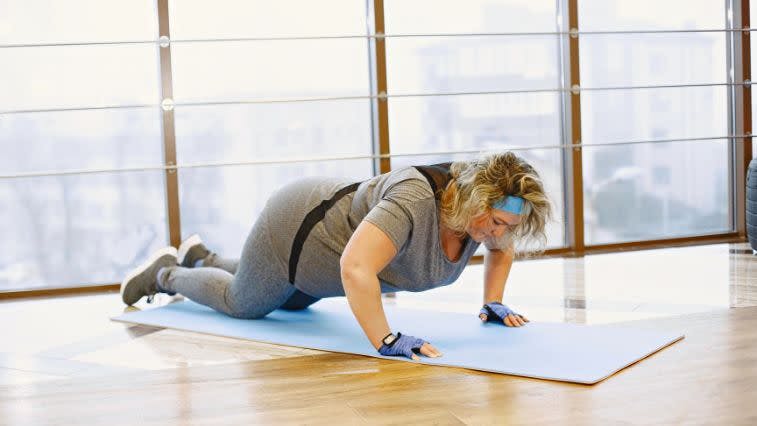How to Build an Exercise Habit with Daily Exercises and 3 Sample Routines
Our content strives to support, inform, and motivate you to meet your health goals. We want to be your trusted source of expert- and science-backed info dispensed in simple, actionable ways. Read our Editorial Guidelines.
Looking to get into shape but don’t know where to begin? You’re in the right place. Prioritizing daily movement is essential for your physical health and emotional wellness. Yet, if you’re starting from scratch, it can be a challenge to figure out exactly what, when, and how to establish an exercise routine.
Patience is a virtue — in life, as well as in cultivating an exercise habit that’s sustainable on a day-to-day basis. If you’re of the mentality that there’s not enough time or energy to add exercise to your daily to-do list, think again!
There’s good news. Building a workout plan that works for your lifestyle doesn't have to be an inconvenient struggle, nor a drain on your time, energy, and budget.
The first step: Determine your end goals and eliminate any obstacles that are getting in the way of achieving them. Next, begin small and work your way up to create an exercise routine that you can integrate into your existing lifestyle.
Ultimately, these daily habits will become a manageable routine that you’re able to maintain to get the long-term results you want.
Whether you’re new to working out or are stumped about how to exercise, what movements to do, and when to do them, this article presents two simple, effective, expert-backed exercise plans to get you started. Plus, you can do the following daily routines at home, with or without equipment, so there’s no extra strain on your time, energy, and budget.
Best of all, you’re just one week away from establishing an exercise habit that you can sustain for the long haul to look and feel your very best.
Build Heart-Healthy Exercise Habits
Before we jump into the what to do, let’s explore the why and how.
It’s no secret that a workout releases stress and makes you feel good. And, the benefits of physical activity go beyond simply triggering exercise-induced endorphins, those feel-good happy hormones. Prioritizing daily movement promotes improved overall health.
Exercise encourages optimal functioning of major organs (such as the heart), assists with normal body functions like repairing and growing bones, and stabilizes essential areas such as the core abdominal muscles that support the spine.
The best way to work the heart and lungs, also known as your cardiovascular system is, well, cardio workouts. You may be familiar with the heart-thumping, lung-busting effort that a high-intensity interval training (HIIT) cardio routine, running or jogging, or jump rope session feels. But, not all cardio needs to feel this way (or should) all the time. Different levels of intensity or heart rate exist, but for those brand new to exercise with an ambitious goal to work out every day or several times a week, start with low-intensity cardio before you add in one or two sessions of moderate-intensity cardio each week.
Your body will tell you if you’re working too hard or just hard enough. If you can’t sustain the effort and pace that you’re doing for more than a couple of minutes, you’re in a high-intensity zone that you should only enter for short intervals once a week at most as a beginner. Dial it back to where you’re breathing a little heavy but still able to maintain a conversation — that’s about moderate-intensity cardio.
“For a beginner cardiovascular workout, I recommend starting to walk either indoors on a treadmill or outdoors,” explains Denise Chakoian, owner + founder of CORE Cycle.Fitness.Lagree, personal trainer, and cancer exercise specialist. “To get more heart health work, increase the incline on the treadmill or do hill walking outside.”
Focus on Form When Weight Training

Beginners should start with their own body weight when it comes to strength training, according to experts, so they can learn the correct movement patterns and make it a priority to perform exercises with proper form.
“For weight training, I recommend always doing it with body weight first, prior to any and all load added on the body,” explains Chakoian. “The rule of thumb is: If you cannot do the exercise without weight with proper form, then we do not add the weight until we get your movement pattern down first.”
Bodyweight exercise examples include the push-up and the squat. Chakoian explains how to modify each move with good form:
Push-up: The push-up can be started standing, using a wall or a large ball to push up or away from, versus starting on your knees or toes on the floor.
Squat: The squat should be done by having a chair behind you to get a good 90-degree angle. Touch your bum down on the edge of the chair before pushing through your heels to stand up, squeezing your glutes together at the top. To progress, remove the chair when you squat down.
Yoga coach and wellness teacher Gwen Lawrence, who works with professional athletes, recommends that those new to exercise should consult with an expert when starting to work out. This will help exercise beginners learn key anatomy points, along with how to execute exercises correctly in order to prevent injuries and be able to maintain a stable, continuous exercise routine.
“I always suggest people to work with a trainer at least a few times to learn proper form so they can continue to work out for a lifetime," says Lawrence.
Rest is an ‘Ab’solute Essential
Now that you’ve got your anatomy and form in check, the next part of the process is to listen to your body’s unique needs and assess how it responds to physical activity. While certain areas of your body, such as the core, can handle daily strength and stabilization exercises, other parts of your body benefit from work on alternate days. The key to building an exercise habit is to ease in, give yourself grace and enough rest, and plan to do a variety of physical activities on different days.
“If you’re doing aerobic workouts without external weights, you can go for it each day. You can also work your abs every day. Not only will you see a better profile, but it also helps support your back and guard against nagging back pain,” says Lawrence.
“However, I recommend you to listen to your body and accept rest when your body tells you. You need to give your ‘worked out’ body parts a 48-hour rest and recovery time. If you’re working out hard, you will need and appreciate the rest anyway,” continues Lawrence.
Add Variety and Self-care to the Daily Mix

To progress and achieve results, mix things up. Both your physical body and brain are wired to respond positively to change, such as doing a different physical activity each day.
“The key is to switch it up for muscle confusion, to keep you interested, and find what brings you happiness and the results you want,” says Lawrence.
Lawrence switches things up to keep her own exercise routine challenging and interesting. Keep in mind that Lawrence is a fitness professional and has been working out for many years (so her exact program isn’t suitable for a beginner). Here’s a sample look at Lawrence’s weekly workout routine:
Monday: Short treadmill workout with stretching in the morning. Lower body workout with heavy weights in the afternoon. Yoga.*
Tuesday:Yoga
Wednesday: Bodyweight leg workout. Yoga.
Thursday: Short treadmill workout with stretching. Upper body workout with heavy weights. Yoga.
Friday: Yoga
Saturday: Bodyweight leg workout. Yoga. Sauna.
Sunday: Yoga. Sauna.
*Lawrence does 30 minutes of yoga every day. She alters the styles from kundalini, yin, or vinyasa yoga.
Your Beginner-friendly Sample Weekly Workout Routine
Read on for the yoga coach and wellness expert’s ideal exercise plan to do each day of the week.
Monday: Focus on leg exercises
Complete 10–12 repetitions of each of the following exercises.
abdominal move of your choice
alternating curtsy lunges
Do the complete routine 1–3 times
Tuesday: Focus on the upper body
Complete 10–12 repetitions of each of the following exercises. Perform all with weights or water bottles, depending on what you have available at home.
chest press or push-upsDo the complete routine 1–3 times
Wednesday: Cardio aerobic activities such as walking or biking for 20–40 minutes
Thursday: Practice yoga or stretch
Friday: Repeat leg exercises from the first day
Saturday: Repeat upper body exercises from the second day
Sunday: Rest or do light, gentle stretching exercises
Chakoian’s Change-Things-Up Exercise Plan

“I recommend doing something different for at least two days in a row,” says Chakoian. “For example, you could do a circuit or HIIT workout on Mondays, and should not do that same workout again until the minimum of Wednesday, but preferably Thursday, to allow more time for recovery. I think ‘surprising’ the body is the best way for overall fitness.”
What follows is Chakoian’s recommended one-exercise-per-day routine for those brand new to exercise who may not be ready for longer workouts each day.
Day One: Perform squats using your body weight. Or, hold light (5 lbs.) or medium (10–15 lbs.) weights in each hand for more of a challenge.
Day Two: Do alternating lunges (bodyweight) with good form, keeping a tall spine and a 90- degree bend when lunging. Again, weights can be added to advance things.
Day Three: While seated on a chair, or standing, do overhead presses. “Seated overhead presses will be more difficult due to the lack of gravity using our legs,” explains Chakoian. “You can use light weights, heavier weights, or if you’re a beginner, use filled water bottles.”
Day Four: Do bicep curls using weights or full water bottles. “This has to be done with the elbows in as close to the ribs as possible if you want to really work the long head of the bicep.”
Day Five: Do tricep dips while seated on the floor. “Hands would go near the hip area with fingers forward, lifting up your glutes in a bridge, then slowly dipping the back of your arms down, and moving them back to straight,” says the fitness pro. “This works the posterior part of the bicep area called the triceps.”
Day Six: Do push-ups while standing up with hands on a wall, on a ball on the floor, or you can drop to your knees for a modified push-up.
Day Seven: Do a high or low plank. A “high” plank is a plank performed with straight arms, and a “low” plank is a plank performed with bent arms with your weight resting on your forearms.
The End Goal
Boosting your health starts by building healthy habits that you can stick with over time. Remember, the body is designed to move, making even 10 minutes or less of movement each day better than none at all.
Begin by building a daily exercise habit and, as you progress, work your way up to adding more time and/or weight resistance. Keep doing this until it feels like a natural part of your day-to-day lifestyle and you’ll be on the path to a lifetime of improved health and fitness.